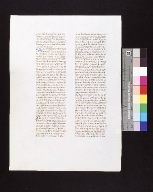|
REFINE
Browse All : Jerome, Saint, -419 or 420. Contra Jovinianum - Illustrations and books and Jerome, Saint, -419 or 420. Contra Jovinianum - Illustrations by Ege, Otto F. of France
1-1 of 1
Title
Contra Jovinianum: fragment
Creator
Jerome, Saint, d. 419 or 20
Summary
[Ms. This manuscript leaf is part of a collection of medieval manuscript leaves selected to illustrate the art of the manuscript during the period of its greatest development and influence. They have been taken from books written in various European scriptoria by Benedictine, Franciscan, Carthusian, Dominican, and other orders of monks. Many are enriched with handsome borders, initial letters, and line-endings rendered in color. Twenty-five are illuminated with burnished gold or silver. The texts include the Bible, various church service books, the writings of the Church fathers, and some of the Classics., In letter de somme, Jerome, the father of the Latin Church and translator of the Bible, shows in his writing his active participation in the controversies of his day (c. 332 to 420 A.D.). With the frequent use of vehement invective, he is often as biting as Juvenal or Martial. This fine book hand, lettre de somme, obtained its name from the fact that Fust and Schoeffer used a type based on it for the printing of their Summa Theologica of St. Thomas Aquinas in 1467. It was the favorite manuscript book hand in the second half of the 15th century for the transcribing of French chronicles and romances. Simplicity and dignity are maintained by omitting all enrichment around the burnished gold letters. The first printed books followed the practice seen here of marking off by hand and with a stroke of red the capitals at the beginning of each sentence. Fifteenth century ink frequently had a tendency to fade to a gray tone as in this example. This vellum leaf was created in France.]
1-1 of 1
|
